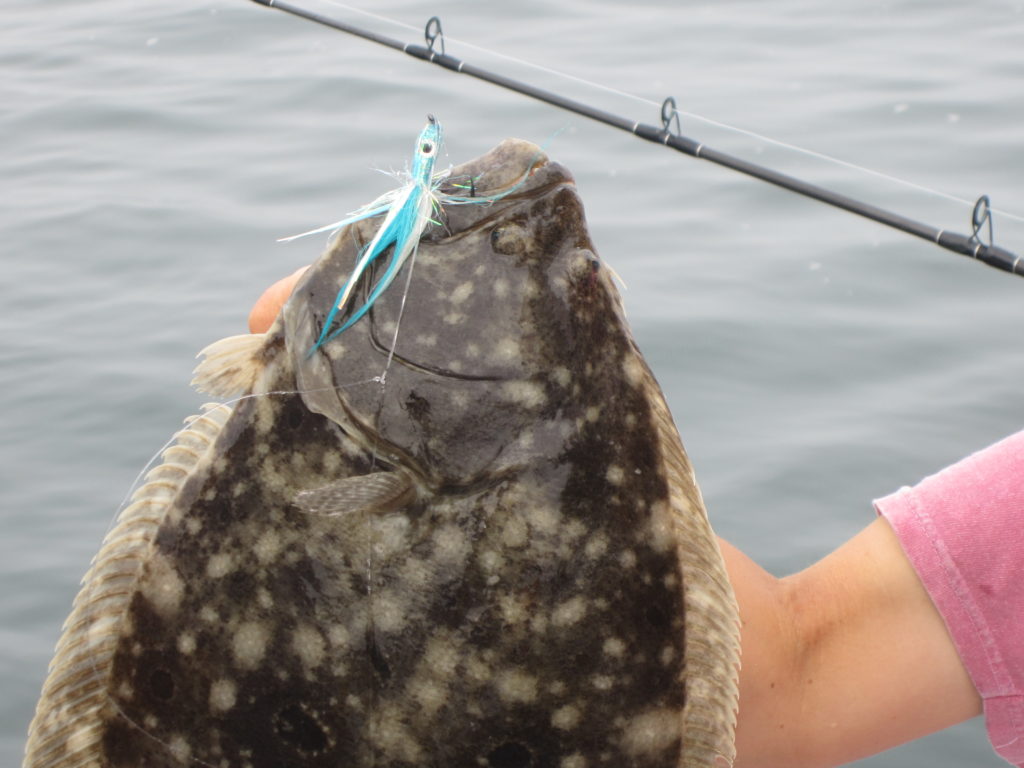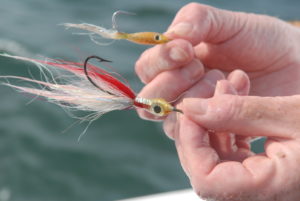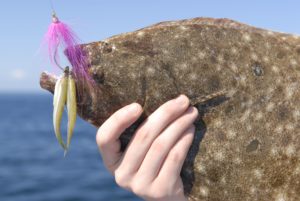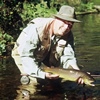FIGURING OUT FLUKE TEASERS, PART 1

Incorporating teasers into your fluke presentations is a sure-fire way to catch more summer flatties. Blue is an overlooked color choice that has produced exceptionally well for the author. Photo courtesy of Deena Lippman, Shinnecock Star, Hampton Bays, NY.
Kicking up a bit of friendly controversy amongst the fluke fishing crowd has never been a difficult task. Often, lively discussion can be spurred with just a simple question or two: What’s the best rig? Should you use bait or jigs? Do channel edges, wrecks or submerged boulder fields produce the biggest fish? There seems to be no shortage of opinions when it comes to what works best for enticing summer flatties.
My favorite starting point for a lively fluke debate centers around the use of teasers. All you have to do to start this up is let the instigator in you announce that your favorite teaser is the doormat king, then step back and let the fun begin. It seems nearly every serious fluke angler has a few deeply held convictions on the topic.
Some anglers, for example, depend on a specific color or pattern, others favor teasers that are sparsely tied while another school holds that full-bodied teasers attract bigger fish. A fair number of fluke sharpies like their teasers to sport wide-gap or octopus-style name-brand hooks, but I know nearly as many excellent fluke fishermen who opt for the simple flash of a little bucktail wrapped around a stainless steel sproat. Among my fluke-seeking buddies are those who position teasers three feet above the bottom hook or jig, others that tie them at six to eight inches, and a slew insisting that 12 to 20 inches above the bottom hook is the right height no matter where you fish.
There are anglers who will use Berkley Gulp!, soft plastic lures and grubs as fluke teasers, those who tie on the cheapest puff of attractant they can buy, and others willing to invest a lot of time and money to create or track down virtual works of art to lure in their summer flatties. All this, and we haven’t even touched on whether or not a teaser should be worked straight up and down or allowed to drop back with a little scope in the line.
Then there is my buddy Michael Potts, skipper of the Montauk charter boat Blue Fin, IV, and one of the better fluke skippers I know. He claims that fluke teasers aren’t really teasers at all since true “teasers” don’t have hooks. “Check your umbrella rig, or an offshore tuna spread,” he antagonized me, “See the hookless tubes and birds? Those are real teasers.”
Ah, the semantics of the fishing game. But Potts is actually right if we get really technical about things. Still, to most local anglers fluke teasers are simply any dressed upper hook on a high-low rig. The primary dressings can include bucktail hair, synthetic materials such as Mylar, Flashabue or Krystal Flash, feathers, soft plastic grubs, actual bait or even a small jig. Call them what you want, and choose whichever style catches your fancy, but know this much is certain: adding a teaser to your favorite fluke rig virtually guarantees more summer flatties over the course of a season.
COLOR BASICS

Choose your teaser to match the dominant bait on which fluke are feeding. Sparse patterns approximate thin profile baitfish like sand eels. Use more robust teasers to match peanut bunker. Photo by Tom Schlichter.
Naturally, there are a few points to keep in mind when selecting fluke teasers and, despite all the debate, several patterns seem to hold true across most fluking hot spots. Consider color, for example. White teasers seem to produce just about everywhere, and these serve as a good control option since you know they should bring at least a fair response. I think they tend to work best in clear water, especially on sunny days.
Chartreuse is another teaser color that sees regular action. Because of its high visibility, it is a great initial choice when the water is murky. Pink is yet a third top producer, especially when the fluke are feeding on local squid in early May, mantis shrimp in late-June, or small calico crabs in July and August. Black works well when you have to deal with a bit of brown tide.
After these choices, it’s a free-for-all. Olive and green have many followers when sand eels or spearing abound. Orange and red match up well to young sea robins. Silver and blue complement peanut bunker, rain bait, baby sea bass or small snappers, while yellow or gold are a good match if juvenile weakfish or a set of small blowfish take up temporary residence in your favorite fluke haunt. No matter the color, most fluke teasers, I think, are made more effective when tied with a white belly section, or at least a few strands of synthetic material that add flash or iridescence to the pattern.
TIPPING IS ENCOURAGED

Larger teasers allow for bigger or multiple baits. Still, you want to keep them as light and lively as possible. Photo by Tom Schlichter.
Tipping fluke teasers with a piece of bait is one theme that seems to have nearly universal appeal. Most sharpies select a single spearing, sand eel or a short, thin strip of squid or fish belly to add a little scent and taste to their offerings. The key is to keep the added bait relatively light so that the teaser will continue to dance seductively above the lower bait or jig. In other words, tip accordingly without being overly generous. Larger teasers can handle larger baits, in which case you might consider tipping with a 4-inch Berkley Gulp! Swimming Mullet or, my personal favorite, a 5-inch Berkley Gulp! Alive! flat-tailed Jerk Shad in new penny or chartresue.
This brings up the question of teaser size. Some anglers use the exact same color and teaser size wherever they fish. Most highly successful fluke anglers, however, base teaser size on where they fish and the size of the fluke they hope to catch. Size 3/0 teasers can provide a lot of fun with short fluke inside bay and harbor waters. They are small enough to provide plenty of action and big enough to turn the head of an occasional keeper. I crush the barbs on these teasers when I fish in shallow areas where shorts are sure to outnumber keepers by a significant margin.
If keepers are definately in the game plan, a size 4/0 to 6/0 teaser is a more logical choice. The larger profile of these sizes seems to discourage short fluke, and sometimes even intimidates sea robins. I like a 4/0 for most of my inlet and sound fishing. For open ocean waters, or ports with a big fish reputation such as Mattituck, Orient or Greenport in the spring, or Montauk any time, the 5/0 size generally works fine. It discourages small fish from biting, can be tipped with a decent sized sweetener, and has the strength to handle the biggest fluke you’ll ever hook. Oftentimes, I’ll double-up with a pair of spearing when using this optoin.
In part 2, we’ll take a look at teaser rigs and techniques.
By Tom Schlichter
Use the LIKE button below to get notifications about new articles in your Facebook news feed!



